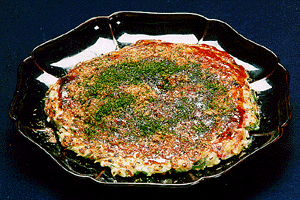Okonomi-yaki
is very versatile, as it can serve as lunch, supper or a snack
with a drink. These days it is very much a food of the people,
unlike the dish from which it is thought to have originated.
Today's okonomi-yaki may have stemmed from a grilled dish
made with wheat gluten. A man called Senno Rikyu first served
this as part of the tea ceremony meal (chakaiseki) in
the Azuchi-Momoyama era (1568-1600). It was essentially a batter
of flour and water spread on a grill, cooked through, brushed
with miso and rolled up like a crepe.
From
this a dish called "monji-yaki"*
developed, which became popular in the Edo era (1600-1868), and
in the Meiji era (1868-1912) "dondon-yaki"** appeared on the scene. The chakaiseki
dish, monji-yaki and dondon-yaki have certain things
in common. Firstly, they are all made from a batter of flour
and water, and have become very popular. Secondly, cooking these
dishes was also a form of play, which was so much fun that even
children wanted to try it.
In about 1932, the sixth
year of the Showa era, dondon-yaki became very popular
in Tokyo's Geisha entertainment world. Dondon-yaki at
that time was made on a 30 cm griddle placed over a charcoal
fire. With the addition of more and more ingredients and seasonings,
the present okonomi-yaki took shape.
Although
it is often thought that okonomi-yaki originated in Osaka,
it actually came to Osaka from Tokyo after World War II. And
when okonomi-yaki hit Osaka, the people of Osaka welcomed
it with open arms.
Osaka people began adding a rich variety of ingredients to okonomi-yaki,
and created a special sweet sauce to spread on top of it. They
began serving it at a counter where the guest could sit and watch
the okonimi-yaki being made. As a result, okonomi-yaki
shops took on a light-hearted, fun atmosphere. Okonomi-yaki
turned into an inexpensive, great-tasting food with enough bulk
to satisfy the appetite.
It seems that Osaka people
are quite prepared to wait in line for good food. Certain okonomi-yaki
shops in Osaka have lines of people waiting to get in every day.
Eventually
okonomi-yaki reached Hiroshima and took on a new form
as Hiroshima-yaki***. Things
often change when other regions adopt them. But different characteristics
developing in different regions make things more interesting.
*Monji-yaki: A very watery batter of flour and water was spread
thinly on a grill and sakura shrimp, squid, agedama
(fried drops of batter) and red pickled ginger were added while
it was cooking. Unlike its predecessor, it targeted children
and took root in working class neighbourhoods. Its name came
from the practice of writing characters in the batter with a
spatula. This was done to teach children characters while making
the monji-yaki.
**Dondon-yaki: The batter was spread out to a 15 cm circle and bonito
powder, kombu kelp flakes and scallions were put on top,
over which more batter was poured. It was cooked on both sides,
spread with sauce, folded in half, put on a thin piece of wood,
wrapped in old newspaper and taken away to eat. Its name came
from the practice of beating a drum outside the shop to attract
children (the sound a drum makes is "don don").
***Hiroshima-yaki: This is different
in that all ingredients are added to the batter once it has been
spread on the griddle. |
